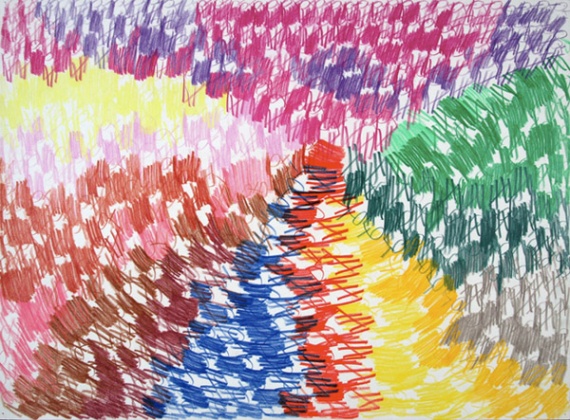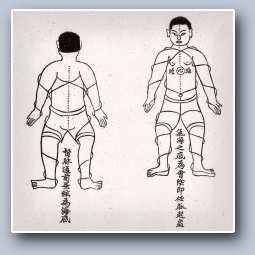SOUZOU – which is pronounced SOZO. It is one of those terms that has a dual meaning and in the context of this enlightening – and at times disturbing – show of 46 self taught Japanese outsider artists it alludes to the force through which new ideas are born and take shape. It’s on at the at the Wellcome Collection in London’s Euston Rd until the end of June and it’s already attracting a steady flow of fans familiar with the Museum Of Everything and Raw Vision magazines.
Upon entering the show
the viewer is immediately drawn into the respective visual worlds of the artists involved. We were confronted with images fastidiously constructed from Japanese Kanji – which takes on a kaleidoscopic form – and from fabric and thread that is skillfully woven to create a piece that exudes the power of a Jackson Pollock. The artworks are grouped under the headings of Language, Making, Representation, Relationships, Culture and Possibility and the range of work is staggering. There are dozens of tiny warrior figures made by Shota Katsube from bin bag twist ties, wild ceramic creatures, ethereal still lives and bold symbolic forms created with Indian ink. Add to that Takashiro Shimoda’s pyjamas festooned with his favourite foodstuff and fabulous little sculptures crafted from strips of paper like the Ganesha above.The Relationship section exudes more than enough pain and led this viewer to seek sactuary in the Culture corner. I was drawn into Daisuke Kibushi’s film posters which are lovingly recreated from memory and Keisuke Ishino’s inspirational army of cellotaped tracing paper figurines rooted in Japanese anime.
By the time we’d reached 17 year old Norimitsu Kubooko’s fabulous fictional cityscape – a finely detailed work in progress that spans a whole wall and is visually constructed from the internet and newspapers – we were exhausted and perhaps convinced we should come again.
One minor criticism is that the curators could have offered – in the style of the Museum of Everything – more background information regarding the environments and the therapeutic communities which the artists are engaged in. It would be good to know more about the Ateliers that have been created to give these individual artists a visual voice.
That said, we can all do our own research and there are talks and workshops accompanying the exhibition. Souzou is complex, illuminating and provides a great deal of food for thought. And for those of you who are tempted to make the journey – the entry fee is FREE! Highly recommended.







Thanks for that Paul, I hadn’t seen that advertised anywhere else